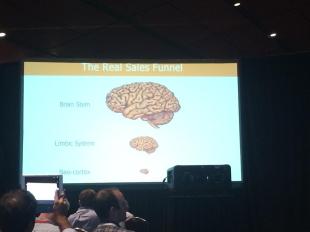Something really struck me yesterday: I think most digital marketers (myself included) are disproportionately focusing their efforts and resources in the wrong place.
I attended Hubspot’s annual INBOUND conference this week. This event has seen incredible growth over the last few years. The first such event had several hundred attendees and this year’s attracted nearly 10,000 marketing professionals from across the world.
This is my can’t-miss event every year, because it never fails to deliver:
- Knowledge: There are hundreds of sessions from some of the brightest and most successful digital marketers in the world.
- Networking: Meeting and chatting with those best and brightest is invaluable.
- Inspiration: I always come away from this event recharged and super-inspired.
I wanted to share my top takeaway from INBOUND14:
We digital marketers are too focused on filling the bucket and not enough with plugging the holes.
I use the word “we” because I nominate myself first and foremost amongst us. And I make this assertion based on admittedly anecdotal evidence: The vast majority of attention of inbound marketers seems to be on how to generate traffic and grow an audience. I don’t see nearly as much time or money focused on improving the conversion rates and this latter category is probably where the lowest hanging fruit is these days.
This became clear to me yesterday afternoon after attending a series of sessions that made me realize that building an audience is really hard work (and getting harder all the time), but improving the quality of your audience and conversion rates can actually be really easy in many cases.
So, why are we digital marketers spending so much time and money to fill a leaky bucket?

Copyright: costasz / 123RF Stock Photo
Search Engine Optimization is Hard (and Getting Harder)
Don’t get me wrong. Just because it’s hard, doesn’t mean you shouldn’t do it. SEO is still a huge part of inbound marketing and always will be. However, I attended two sessions about SEO that just make your hair hurt. Danny Sullivan and Rand Fishkin both made presentations about the current state of SEO and both of them had similar messages: It’s kind of a mess.
Sullivan’s presentation focused on the changing landscape of search results. It’s really hard to even describe what a #1 ranking means, let alone figure out how to achieve it. He then discusses recent Google updates and penalties, along with some tactics we should leave behind as a result. You can see his presentation here:
Fishkin’s presentation was similar and presented an even bleaker picture – especially for some larger websites like the NFL and Expedia. He covers several tactics to leave behind and several new tactics to address the changing landscape.
*GASP* I Don’t Pay for Love!
Not that kind of love. I’m talking about using PPC for content marketing. Actually, it was Larry Kim, founder of Wordstream, who talked about it. It’s borderline heresy to talk about paying for traffic at an inbound conference, but he was making the case for one of my newest favorite tools; retargeting. He talked about three problems that he was having with the Wordstream website, despite lots of traffic:
- Low visitor engagement: Only about 20% of his traffic came from returning visitors.
- Low conversion rate: The average conversion rate from blog content was low single digits.
- Low brand recall: His branded search traffic was extremely low.
The rest of his presentation made the case for using remarketing as part of your content marketing strategy. It’s essentially a conversion rate optimization strategy that uses paid advertising. His presentation is embedded below and contains tons of great tips:
Conversion Rate Optimization Is Easier
I hate to use a word like “easier,” because nothing is truly easy. But in the context of this article, I’m measuring it relative to search engine optimization. Tim Ash hosted two sessions on conversion rate optimization. The first was titled Conversion Hacking the Brain. He described “the real sales funnel,” which involve our three different brains; the brain stem, the limbic system (or lizard brain), and the neocortex.
His fundamental point is that regardless of how rational we like think we are, our decisions are emotional. That’s a biological fact, not opinion. And it has huge implications for web page design and conversion rate optimization. He offered the following tips:
- Create a small number of clear choices. Making choices tires the brain. Help guide (wizards, not filters) users, don’t overwhelm them, and remove similar choices.
- Use a big anchor. Use the anchoring effect to your advantage. For example, on a pricing page put expensive stuff first, then show other prices in decreasing order.
- Be in my cultural tribe. People are tribal. We care more about people similar to us, so look the part. Communicate your values with editorial tone and don’t worry about alienating outsiders.
- Understand the power of visuals. Video wipes out graphics. Graphics wipe out text. Visual processing is very powerful & quick. Draw attention to offers with strong visuals. Use people carefully to support calls-to-action. Don’t use unnecessary video or motion.
As of the publication of this article, I hadn’t located Tim’s slide deck online but I’ll update this post when and if he posts it.
The second session was a rapid-fire, live review of landing pages provided by the audience. This was the session that really caused me to write this post. He looked at about a dozen different home and landing pages and pretty much tore them to shreds. As he did so, I recognized many mistakes I consistently make and saw a huge opportunity to improve the overall performance of my websites.
Thanks to @tim_ash, I have about a dozen home pages I need to redesign this weekend. So much actionable advice! #inbound14
— Jon DiPietro (@JonDiPietro) September 18, 2014
Conclusion: Work Smarter
I know. “Work smarter, not harder” is a cliche of the highest order. But it really is at the heart of this argument. Given the amount of time (or extraordinary luck) required for results from pure inbound marketing – which is to say SEO and social media – perhaps our resources can achieve better results if they’re applied in other areas.
Let’s do a little math.

The first line in this table is our baseline data. The second line shows the effect on revenue by doubling the amount of traffic. The third line shows the effect on revenue by doubling the conversion rate and the per-lead value. I’m arguing in this blog post that by optimizing landing pages and implementing retargeting, you can get much greater bottom line results for less effort than SEO and social media.
Again, this is not an either/or decision. I’m not saying that you should do one in place of the other. It’s a question of prioritization. I think that by paying a little less attention to growing our audience and little more to conversions and audience quality, we can see much better bottom line results.


Thanks for the nice recap of my sessions at #Inbound14!